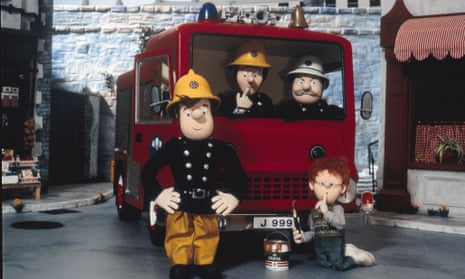Dave Jones, creator
I worked at a Clerkenwell fire station in London in the early 1980s. You’ve got to really want to be a fireman, because the wages are terrible. The advantage is that you have a lot of spare time – doing a single 15-hour night shift might constitute most of your working week. All of us had other, part-time jobs.
I’d been a motorcycle messenger, a carpenter and an odd-job man and then I started a mail-order company that made figurines and memorabilia of uniformed workers. The pieces we sold ranged from little plastic firemen’s hats to Royal Worcester china. A lot of kids were buying them, so I thought: I should create a character and write some children’s stories about firemen. My daughter came up with the name Sam.
I was considering self-publishing them, but then I heard a radio interview with Mike Young, who created the cartoon character SuperTed. I phoned the BBC to ask for his number. They were difficult about it, but I chatted up the receptionist. When I got past Mike’s secretary he said: “I get 10 calls a day from people like you.” I said: “You don’t – this is something special.”
I asked my company’s figurine-maker to create a model of Sam. I gave the guy one of my uniforms, and he made his wife put it on so he could work from it. After I sent the model to Mike, he called me and said: “You better come down here, this is good.” He introduced me to Rob Lee, an artist at his production company, and we developed the series for the next two years. It was all done in stop-frame animation – very twee, very nice.
There was a gap in children’s programming for a hero like Sam. Postman Pat was around, but how much can a postman really do? And the public safety message we put out was good. There were far more fires in the 80s, and , and fewer smoke detectors or sprinklers. People had paraffin heaters, and paraffin is volatile stuff to have in your house.
I’ve been asked, how one village could have had so many disasters? And it’s a good point: we could only come up with so many storylines. There’s a helicopter in the new CGI version, which is a bit weird. They must have run out of plots.
Rob and I teamed up for another show, Joshua Jones, and that was a bit of a disaster. A lot of the profits from Fireman Sam went into creating it, but we didn’t know there was another series in production that was almost identical: Rosie and Jim. That show was much more aggressively marketed, and we were swamped by it. A lot of money was lost on that. But these things happen.
Rob Lee, artist and screenwriter
I liked the idea of a vocational character – everyone wants to be a builder or policeman or fireman. And Dave’s enthusiasm was enormous: he was determined to get our attention.
The idea was for me to write the storylines, and I didn’t envisage beyond 10 episodes. Then I realised that if I wrapped it around a strong cast of civilian characters, the series could have the feel of a soap opera. There’s almost a social realist tone to it. It wasn’t two-dimensional emotion – fear v bravery – there were also lots of grey areas. If there was a malaise or sadness in the story, you felt it. In the US, they say they really like the show’s morality.
The naughty boy, Norman, was unashamedly derived from Dennis the Menace. The touchstone for Dilys Price was Hilda Ogden from Coronation Street, a nosy old lady; Carol Vorderman once told me she loves her. Trevor was a bus driver and, because we were a bit short of cash for extra models, also a subsidiary fireman.
They all counterbalanced the inherent goodness of Sam. It was important he looked approachable, and strong, but also have a sense of vulnerability about him. We stuck a quiff on him – otherwise all the characters looked the same when they had helmets on. It’s like with Mickey Mouse: if you can recognise them in a black and white profile, you’ve got a good character.
CGI has a cool sheen that distances you from it, but you get something quaint and warm with this stop-frame animation, like old slippers. You become part of the story, instead of observing it. It was a bugger to make, though. Getting the models to walk was hard to do; floods were even harder.
In fact, you had to be very careful about any water or snow. Christmas scenes had to be in the final episode of the series, because once the snow was on the building we couldn’t get it off again. I once wrote a windy-day scene and wanted a can to roll down the street. The animators were awake half the night trying to figure out how to do it. I didn’t go over to the animation studio very often – it was too tense.
Several children’s lives have been saved as a result of Fireman Sam. Kids have put out shed fires, or rescued their brothers or sisters, because of what they’d seen on the show. How good is that?

Comments (…)
Sign in or create your Guardian account to join the discussion